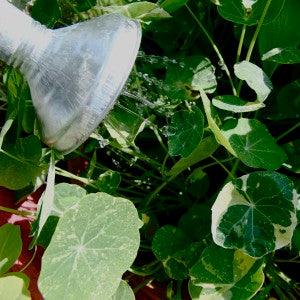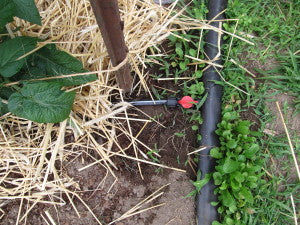 Plants, just like us, are composed mostly of water. They need it to perform vital life processes like germinating, growing, keeping themselves upright, flowering, fruiting, and forming seeds. Plants also absorb nutrients in a dissolved form, so they need water to stay healthy ward off diseases, and pass on maximum nutrition to us, at harvest time.
Plants, just like us, are composed mostly of water. They need it to perform vital life processes like germinating, growing, keeping themselves upright, flowering, fruiting, and forming seeds. Plants also absorb nutrients in a dissolved form, so they need water to stay healthy ward off diseases, and pass on maximum nutrition to us, at harvest time.
How plants get their water is the big question. Ideally, they receive adequate moisture from rain, but as growers know all too well – that doesn’t always happen when moisture is needed most. In the garden, the difference between irrigating and not can mean a poor harvest, or a wilted floral landscape, so for most gardeners and farmers, there comes a time when supplementing moisture provided by nature becomes unavoidable. As we enter the driest part of the year here in the Northeast, we’ve compiled a few suggestions for good watering practices:
How much?
The standard suggestion for vegetable watering requirements is one inch per week. The easiest way to measure this is by setting up a rain gauge in the garden and keeping a record of the level every time it rains. Without a rain gauge, can test the soil moisture level with your finger, by sticking it in the soil as far down as it will go and feeling for moisture. If your finger feels completely dry, it is time to water.
Soil composition is another factor to consider. If your soil feels closer to clay, water will both be pulled away from the plant’s roots and will drain slower. If your soil is, instead, very sandy, water will drain quicker and the plants may need to be watered more often. Get to know your soil and add organic material if you need to get it to better shape for growing vegetables.
A plant’s life cycle dictates how much water it needs. During the germination phase, a few weeks after transplanting, and young plants in general appreciate a lot of water. As they mature, wean them off of a daily watering schedule and use the one inch per week guideline. Once a week or every 10 days watering is adequate for most mature plants. Most crops have roots zones in the top eight inches of soil – it is important that the amount of water you provide seeps down that far.
Different plants have different moisture needs, which is a good thing to consider not just when watering, but when planning out your crop layout. Herbs, for example, are very drought tolerant and can actually gain flavor when growing in drier conditions. Tender greens, like lettuce or mustards, are the opposite – they ask for a lot of water to not only grow well, but to keep from becoming too bitter or spicy. Root crops should be watered liberally at first to help form a healthy plant, but as they get close to maturity, overwatering can split the root.
The weather is, of course, a big factor in deciding how much to water, but not just whether it is raining or not. Moisture evaporates quicker in the heat, when the humidity is low, the sky is clear, or the wind is strong. On the other hand, cool, cloudy weather can keep the soil moist for weeks.
How to?
Water roots, never leaves. Any watering effort should focus on the root zone, never the foliage. Watering leaves can singe them if done in the peak heat of the day or cause fungal diseases and they do not absorb enough water for the plant to use. Leaves can also be unreliable indicators when it comes to watering: if they droop in the hottest part of the day, chances are, they are just conserving energy and will perk up once the temperature cools. If, however, they are drooping in the morning or evening, it’s time to check soil moisture.
Water more, less often. To encourage a strong root system, it is best to saturate the soil after it dries, instead of lightly watering the surface daily. Light, frequent watering will make the roots grow toward the surface in search of moisture, instead of reaching deeper down.
Water in daylight hours. Morning, afternoon, or early evening are the best times to water. Watering at night is not recommended because droplets can sit on the leaves until the sun comes out again, and this can cause fungal issues.
Keep on weeding. Weeds near your crops will suck out some of the water available to your crops, so keeping your beds consistently weeded will help maintain moisture levels in the garden.
With what?
 The size of your garden or its proximity to a water source will determine what will be the best set up for you. For small spaces, a simple watering can should do the trick. For a slightly bigger garden, hand-watering with a hose (near the root zone!) is a popular solution. And, for a large space or a very busy gardener, drip-tape or a soaker hose is a great system. It releases a small amount of water slowly, over several hours, allowing ample time for the soil to absorb it.
The size of your garden or its proximity to a water source will determine what will be the best set up for you. For small spaces, a simple watering can should do the trick. For a slightly bigger garden, hand-watering with a hose (near the root zone!) is a popular solution. And, for a large space or a very busy gardener, drip-tape or a soaker hose is a great system. It releases a small amount of water slowly, over several hours, allowing ample time for the soil to absorb it.
Adding mulch to your beds, or planting some crops in rows covered with black plastic can significantly increase how much moisture stays in the soil.
To use water wisely, consider setting up a collection system, instead of relying on the tap. This could be as simple as a rain barrel at the end of your gutter or as grand as digging a pond. Many plans for rainwater collection are available online, for free. Permaculture forums are a good place to start your research.





